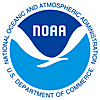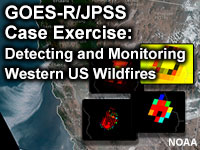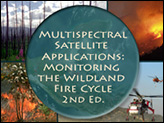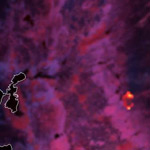Training: Fire
Click on the thumbnail images or links below to launch/redirect to each training course.
Cooperative Program for Operational Meteorology, Education, and Training (Comet)
 The Cooperative Program for Operational Meteorology, Education, and Training supports, enhances, and stimulates the communication and application of scientific knowledge of the atmospheric and related sciences for the operational and educational communities. COMET’s web-based self-paced training materials serve earth science education and training needs by providing interactive experiences for learners at a distance. Experts at both the Cooperative Institute for Meteorological Satellite Studies (CIMSS) and the Cooperative Institute for Research in the Atmosphere (CIRA) contributed to many of these lessons.
The Cooperative Program for Operational Meteorology, Education, and Training supports, enhances, and stimulates the communication and application of scientific knowledge of the atmospheric and related sciences for the operational and educational communities. COMET’s web-based self-paced training materials serve earth science education and training needs by providing interactive experiences for learners at a distance. Experts at both the Cooperative Institute for Meteorological Satellite Studies (CIMSS) and the Cooperative Institute for Research in the Atmosphere (CIRA) contributed to many of these lessons.
GOES-R/JPSS Case Exercise: Detecting and Monitoring Western US Wildfires
GOES-R/JPSS Case Exercise: Detecting and Monitoring Western US Wildfires: This lesson provides information on GOES-R and JPSS improved capabilities for detecting and monitoring wildland fires in the Western US and similar geographic regions. The California Kincade fire of October 2019 is highlighted. In this case, satellite monitoring capabilities provided useful tactical information to meteorologists who were working with fire agencies, emergency managers and first responders throughout the life of the fire. Combined with the knowledge on the ground and the tireless work of individuals who were battling the blaze, many people were effectively removed from danger and the impacts of this fire were less significant than they could have been had it not been effectively monitored using an array of tools, including satellite.
Multispectral Satellite Applications: Monitoring the Wildland Fire Cycle, 2nd Edition
Multispectral Satellite Applications: Monitoring the Wildland Fire Cycle, 2nd Edition: This lesson describes current and future satellite sensors and products used for monitoring the fire cycle. Product information is presented in the context of the fire lifecycle: from assessing the pre- and post-fire environment to detecting and monitoring active fires, smoke, and aerosols. This updated version of the lesson includes new information on GOES-R fire-related applications.
Satellite Feature Identification: Ring of Fire:
Satellite Feature Identification: Ring of Fire: Introduces forecasters to the potentially damaging convection that can develop in conjunction with blocking high pressure centers and examines how to identify it from a water vapor imagery perspective. This module is also available in French and Spanish.
NASA’s Short-term Prediction Research and Transition Center (SPoRT)
 NASA’s Short-term Prediction Research and Transition Center (SPoRT) provides training about specific products, discussing the strengths and weaknesses, with the goal of successfully transitioning products to operations. This training is built from surveys and direct communication with our partners. With this paradigm, the forecasters are an integral component of the transition process and not a passive recipient of data.
NASA’s Short-term Prediction Research and Transition Center (SPoRT) provides training about specific products, discussing the strengths and weaknesses, with the goal of successfully transitioning products to operations. This training is built from surveys and direct communication with our partners. With this paradigm, the forecasters are an integral component of the transition process and not a passive recipient of data.
Day Land Cloud Fire RGB
Day Land Cloud Fire RGB: The focus of this micro-lesson is on the Natural Color Fire RGB product. This RGB is similar to the Day Land Cloud or Natural Color RGB; however, one of the channels is replaced to specifically focus on fire hot spots. The RGB allows one to view the smoke and fire hot spots within the same product. The case used for this object is the October 2017 Northern California Firestorm. The objective for this item is to have the forecaster demonstrate the ability to identify various hot spots within the Day Land Cloud Fire RGB imagery.
Fire Temperature RGB
Fire Temperature RGB: This micro-lesson illustrates the application of the Fire Temperature RGB developed originally using the VIIRS imager on Suomi-NPP and translated for use with the GOES-16/17 ABI. This RGB takes advantage of the difference in saturation of several short-wave infrared channels when sensing wildfires. Traditional “hotspots” via short-wave infrared imagery is compared to the RGB imagery which provides an intensity estimate based on the saturation level of the individual channels.
Virtual Institute for Satellite Integration Training (VISIT)
 Virtual Institute for Satellite Integration Training (VISIT) is a joint effort involving NOAA Cooperative Institutes, the National Environmental Satellite Data and Information Service (NESDIS), and the National Weather Service (NWS). The primary mission of VISIT is to accelerate the transfer of research results based on atmospheric remote sensing data into NWS operations using distance education techniques. Training sessions include topics on satellite meteorology, severe weather, climate, numerical weather prediction, and more.
Many of these modules were developed in collaboration with the Cooperative Institute for Meteorological Satellite Studies (CIMSS) and the Cooperative Institute for Research in the Atmosphere (CIRA). VISIT also provides satellite chats to demonstrate satellite products that can be applied to operational forecasting and identify new training topics based on specific participant needs. See the VISIT Training Calendar for upcoming teletraining sessions.
Virtual Institute for Satellite Integration Training (VISIT) is a joint effort involving NOAA Cooperative Institutes, the National Environmental Satellite Data and Information Service (NESDIS), and the National Weather Service (NWS). The primary mission of VISIT is to accelerate the transfer of research results based on atmospheric remote sensing data into NWS operations using distance education techniques. Training sessions include topics on satellite meteorology, severe weather, climate, numerical weather prediction, and more.
Many of these modules were developed in collaboration with the Cooperative Institute for Meteorological Satellite Studies (CIMSS) and the Cooperative Institute for Research in the Atmosphere (CIRA). VISIT also provides satellite chats to demonstrate satellite products that can be applied to operational forecasting and identify new training topics based on specific participant needs. See the VISIT Training Calendar for upcoming teletraining sessions.
VISIT Training Sessions:
VISIT offers a wide selection of satellite remote sensing training materials. See the VISIT Training Sessions webpage for a complete listing.
FDTD Satellite Application Webinars:
The National Weather Service Forecast Decision Training Division (FDTD) Satellite Application Webinars are peer-to-peer learning; staff from Weather Forecast Offices (WFOs), National Centers, Center Weather Service Units (CWSUs), and River Forecast Centers (RFCs) lead the presentations. The webinars to share how to apply GOES imagery with other datasets for a specific operational application.











